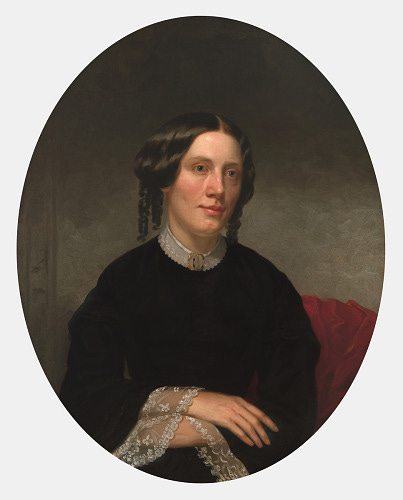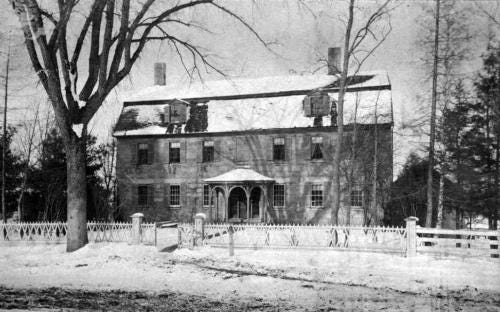Long Memories, a history of Andover in ten (or so) trees: Harriet Beecher Stowe's "Old Oak of Andover"
For many years in the town's history, visitors commonly asked directions to the ancient tree made famous by the best-selling author of "Uncle Tom's Cabin."
Trees can be a useful metaphor to explore how scenes and episodes from one town’s history are interconnected with the larger world. This is third in a series telling the stories of some of Andover’s best-known trees as well as the people who loved, planted, and nurtured them. You can read the first two installments here and here.

Barbara Walters: What kind of tree are you?
Katharine Hepburn: Oh, not an elm . . . everybody would like to be an oak tree. That’s very strong. Very pretty.
Many people today are familiar with Phillips Academy’s beautiful and iconic “Great Elm,” planted sometime between 1720 and 1740, making it the oldest tree on campus and one of the oldest in the country. You can read Gail Ralston’s Andover story on the tree here or watch this Phillips Academy video on its care and preservation.

The Seminary Oak
A hundred and fifty years ago, it was more common for sightseers and visitors to the Andover campus to ask directions to another tree: the “Seminary Oak,” made famous by Harriet Beecher Stowe’s lovely 1855 essay, “The Old Oak of Andover.” Did this three-hundred-year-old tree, they asked, still stand?

“Right opposite our house,” the celebrated author had written, “on our own Mount Clear”—a metaphor from John Bunyan’s The Pilgrim’s Progress for the spiritual heights from which a mature Christian has an unobstructed view—“is an old oak, an apostle of the primeval forest.” In gorgeous prose, she describes the “stanch old fellow” at length: “His limbs have been here and there shattered; his back begins to look mossy and dilapidated; but after all, there is a piquant, decided air about him, that speaks the old age of a tree of distinction, a kingly oak.” The tree was akin to the Puritan fathers of Andover, she wrote, who had been its contemporary. “Such strong, wrestling limbs had they, so gnarled and knotted were they, yet so outbursting with a green and vernal crown, yearly springing, of noble and generous thought, rustling with leaves which shall be for the healing of nations . . . Let us cherish for their sake the old oak, beautiful in its age as the broken statue of some antique wrestler, brown with time, yet glorious in its suggestion of past achievement.” The rest of the essay is a spirited defense of the old-time Puritanism still taught and practiced on Andover Hill against accusations that it lacked, in its austere white churches, an appreciation for beauty. You can read the entire essay here.

Harriet Beecher Stowe was already a best-selling author when she came to Andover in 1852, moving with her large, lively family into a remodeled stone building on Chapel Avenue, now the site of the Andover Inn. Her husband Calvin Stowe was, like her father Lyman Beecher, a distinguished theologian and scholar, and Harriet herself was accustomed to considering the whole meaning of life in terms of Calvinistic doctrine. Writing Uncle Tom’s Cabin had been for her an essentially religious rather than a social or political act. She spent much of 1853 on a triumphant tour of Europe, feted and applauded at every stop, but seemed, from her writings, to be meditating not so much on her fame but on the new view of Puritanism she gained from the European perspective. After touring the cathedrals and great religious art of the Continent as well as the ruins of altars and whole churches in England and Scotland hacked to pieces by Cromwell’s reforming army, she could no longer pretend the Calvinism of her unquestioning youth was “all-lovely.” Coming home to Andover, however, and then helping her father write his autobiography, she was convinced again of the faith’s dignity and worth. The Old Oak of Andover was written during what she called this “sunny period” of her life, before the tragic death of her son Henry in 1857 brought her doubts again crashing down upon her.

The tree itself, as Mrs. Stowe describes, was reputed to have been used “when this place was all wildwood,” by Eliphalet Pearson, “the man who was seeking a spot for the location of the buildings of Phillips Academy. . .as a sort of green watchtower, from whence he might gain a view of the surrounding countryside.” A talented teacher, botanist and chemist, Pearson was the first Principal of Phillips Academy (1778-1786) and acting President of Harvard (1804-1806) who resigned the latter post in protest of the college’s election of a liberal Unitarian to a prominent Divinity chair. Determined to establish an orthodox school to “maintain the doctrine of the fathers of New England against the threatening apostasies of the time,” he raised funds from wealthy merchants in Boston and Newburyport for the seminary to be located in Andover. Judge Samuel Phillips, Jr. and his family were prominent donors, providing gifts totaling over $100,000 for building and the acquisition of land adjacent to the smaller Phillips Academy.

As years passed and people’s memories dimmed, more questions and confusion arose around both the location of Mrs. Stowe’s tree and whether it had any historic significance anyway. Was it possible the famous author, using poetic license for the metaphoric effect, had exaggerated the oak’s size, location and relative infirmity?
Andover historian Charlotte Helen Abbott, in her 1899 catalog of the town’s historic trees1, cites an 1853 description of an apparently different tree: the “broad spreading oak” standing near the corner of Main and Chapel Streets circa 1810 that was one of the few trees remaining after the extensive Parish wood lot was felled for the construction of the Essex Turnpike (now Main Street/Route 28) in 1806. She surmises that “the two well grown oaks . . .on the Seminary grounds and a fine tree on the roadside behind the old gymnasium” were “probably acorns when the [older] oak tree was cut down, more than 80 years ago to make way for Phillips Academy.” The significance for her of this ancient oak was its tradition for marking the place “over the hill up the road from the garrison” where her kinsman Joseph Abbott was killed by Pennacooks in 1676, while clearing the Abbott meadow border for settlement. She admits in this family genealogy that the twenty-four-year-old Abbott, known to have committed military atrocities against the Wamesit (now Tewksbury) people following the Narragansett War swamp fight the previous winter, probably “suffered justly.”
Writing in 1914, sixty years after the publication of Mrs. Stowe’s essay and six years after the Seminary had moved from Andover to Cambridge, memoirist Susan E. Jackson addresses the confusion and corrected an apparent error published several years previously. “The ‘old oak’ in the rear of Bartlet Chapel [later renamed Pearson Hall] is not the one of which Mrs. Stowe wrote—that one was nearly in the rear of the Stone Church [built on Chapel Avenue in 1876, well after the Stowes had left town and built their dream home (interestingly named Oakholm) in Hartford, Connecticut.
Jackson’s use of the past tense, as well as Miss Abbott’s failure to include the tree in her 1899 inventory, indicates that “the Old Oak Tree of Andover” had likely fallen some years previously. It isn’t shown in images and descriptions of the Stone Church made prior to the building’s demolition in 1931.
So what do you think?

More to come . . .
In the next entry of “Long Memories” I’ll share another story of a historic town tree. I love questions and comments. Click here to open a free Substack account, so you can like, share, and comment.
Thanks for reading!
Jane
History Buzz is a reader-supported publication. To receive new posts and support our work, consider becoming a free or paid subscriber.
Andover Townsman (October 1899) Charlotte Helen Abbott “The Trees of Andover”






Stowe may have bent the facts just a little bit to enhance the legacy of her magnificent elder statesman oak, but at least he lives on in her writing. Fiction writers will take liberties. ;-) Nice article!
This is such a great idea for a series! I’ve enjoyed all of the articles so far and look forward to more. There’s a large tree on High Plain Road, in between the dog park and the compost yard, that’s significantly older than the other vegetation surrounding it. I’ve always wondered what the property may have been and, if the tree could talk, what stories it might tell.